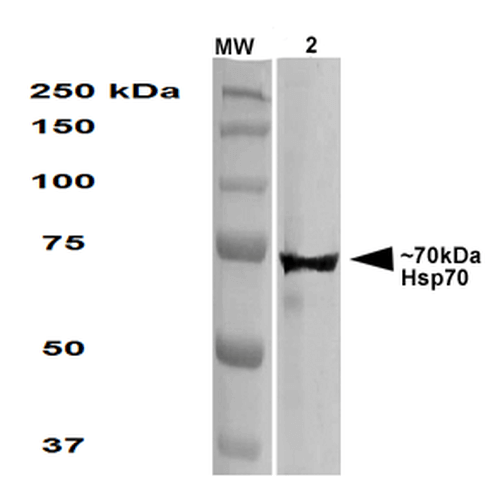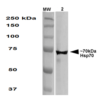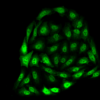Anti-Hsp70 Antibody (11139)
$344.00
| Host | Quantity | Applications | Species Reactivity | Data Sheet | |
|---|---|---|---|---|---|
| Mouse | 100ug | WB,ICC/IF,ELISA | Human, Mouse, Rat, Bovine |  |
SKU: 11139
Categories: Antibody Products, Heat Shock and Stress Protein Antibodies, Products
Overview
Product Name Anti-Hsp70 Antibody (11139)
Description Anti-Hsp70 Mouse Monoclonal Antibody
Target Hsp70
Species Reactivity Human, Mouse, Rat, Bovine
Applications WB,ICC/IF,ELISA
Host Mouse
Clonality Monoclonal
Clone ID 1.86
Isotype IgG1
Immunogen Purified bovine Hsp70 (accession no. NP_776975.1).
Properties
Form Liquid
Concentration 1.0 mg/mL
Formulation PBS, pH 7.4, 50% glycerol, 0.09% sodium azide.Purified by Protein G affinity chromatography.
Buffer Formulation Phosphate Buffered Saline
Buffer pH pH 7.4
Buffer Anti-Microbial 0.09% Sodium Azide
Buffer Cryopreservative 50% Glycerol
Format Purified
Purification Purified by Protein G affinity chromatography
Specificity Information
Specificity This antibody recognizes inducible bovine, human, mouse and rat Hsp70. It does not cross-react with Hsc70.
Target Name Heat shock 70 kDa protein 1A
Target ID Hsp70
Uniprot ID Q27975
Alternative Names Heat shock 70 kDa protein 1, HSP70.1
Gene Name HSPA1A
Gene ID 281825
Accession Number NP_776975.1
Sequence Location Cytoplasm, Nucleus, Cytoplasm, cytoskeleton, microtubule organizing center, centrosome
Biological Function Molecular chaperone implicated in a wide variety of cellular processes, including protection of the proteome from stress, folding and transport of newly synthesized polypeptides, activation of proteolysis of misfolded proteins and the formation and dissociation of protein complexes. Plays a pivotal role in the protein quality control system, ensuring the correct folding of proteins, the re-folding of misfolded proteins and controlling the targeting of proteins for subsequent degradation. This is achieved through cycles of ATP binding, ATP hydrolysis and ADP release, mediated by co-chaperones. The co-chaperones have been shown to not only regulate different steps of the ATPase cycle, but they also have an individual specificity such that one co-chaperone may promote folding of a substrate while another may promote degradation. The affinity for polypeptides is regulated by its nucleotide bound state. In the ATP-bound form, it has a low affinity for substrate proteins. However, upon hydrolysis of the ATP to ADP, it undergoes a conformational change that increases its affinity for substrate proteins. It goes through repeated cycles of ATP hydrolysis and nucleotide exchange, which permits cycles of substrate binding and release. The co-chaperones are of three types: J-domain co-chaperones such as HSP40s (stimulate ATPase hydrolysis by HSP70), the nucleotide exchange factors (NEF) such as BAG1/2/3 (facilitate conversion of HSP70 from the ADP-bound to the ATP-bound state thereby promoting substrate release), and the TPR domain chaperones such as HOPX and STUB1. Maintains protein homeostasis during cellular stress through two opposing mechanisms: protein refolding and degradation. Its acetylation/deacetylation state determines whether it functions in protein refolding or protein degradation by controlling the competitive binding of co-chaperones HOPX and STUB1. During the early stress response, the acetylated form binds to HOPX which assists in chaperone-mediated protein refolding, thereafter, it is deacetylated and binds to ubiquitin ligase STUB1 that promotes ubiquitin-mediated protein degradation. Regulates centrosome integrity during mitosis, and is required for the maintenance of a functional mitotic centrosome that supports the assembly of a bipolar mitotic spindle. Enhances STUB1-mediated SMAD3 ubiquitination and degradation and facilitates STUB1-mediated inhibition of TGF-beta signaling. Essential for STUB1-mediated ubiquitination and degradation of FOXP3 in regulatory T-cells (Treg) during inflammation. Negatively regulates heat shock-induced HSF1 transcriptional activity during the attenuation and rUniProtKB:P0DMV8}.
Research Areas Heat Shock& Stress Proteins
Background Hsp70 genes encode heat-inducible 70kDa heat shock proteins. Hsp70 binds ATP with high affinity and possesses weak ATPase activity which can be stimulated by binding to unfolded proteins and synthetic peptides. The structure of the ATP binding domain displays multiple features of nucleotide binding proteins. The binding of ATP triggers a critical conformational change which leads to the release of the bound substrate protein. The universal ability of Hsp70s to undergo cycles of binding to and release from partially unfolded proteins is the basis of their role in protein synthesis, protein folding, oligomerization, and protein transport.
Application Images



Description Western Blot analysis of Human Embryonic kidney epithelial cell line (HEK293) lysates showing detection of ~70 kDa Hsp70 protein using Mouse Anti-Hsp70 Monoclonal Antibody, Clone 1.86 (11139). Lane 1: MW ladder. Lane 2: Human HEK293 lysate (20 µg). Load: 20 µg. Block: 5% milk + TBST for 1 hour at RT. Primary Antibody: Mouse Anti-Hsp70 Monoclonal Antibody (11139) at 1:500 for 1 hour at RT. Secondary Antibody: HRP Goat Anti-Mouse at 1:100 for 1 hour at RT. Color Development: TMB solution for 5 min at RT. Predicted/Observed Size: ~70 kDa.

Description Immunocytochemistry/Immunofluorescence analysis using Mouse Anti-HSP70 Monoclonal Antibody, Clone 1.86 (11139). Tissue: Cervical cancer cell line (HeLa). Species: Human. Fixation: 4% Formaldehyde for 15 min at RT. Primary Antibody: Mouse Anti-HSP70 Monoclonal Antibody (11139) at 1:100 for 60 min at RT. Secondary Antibody: Goat Anti-Mouse ATTO 488 at 1:100 for 60 min at RT. Counterstain: DAPI (blue) nuclear stain at 1:5000 for 5 min RT. Localization: Nucleus, Cytoplasm. Magnification: 40X.
Handling
Storage This antibody is stable for at least one (1) year at -20°C.
Dilution Instructions Dilute in PBS or medium which is identical to that used in the assay system.
Application Instructions Immunoblotting: use at 1ug/mL. A band of ~70kDa is detected
ELISA: use at 1-10ug/mL with Hsp70 sample on the solid phase.
Positive control: HeLa cell lysate.
These are recommended concentrations;
Enduser should determine optimal concentrations for their applications.
ELISA: use at 1-10ug/mL with Hsp70 sample on the solid phase.
Positive control: HeLa cell lysate.
These are recommended concentrations;
Enduser should determine optimal concentrations for their applications.
References & Data Sheet
Data Sheet  Download PDF Data Sheet
Download PDF Data Sheet
 Download PDF Data Sheet
Download PDF Data Sheet




